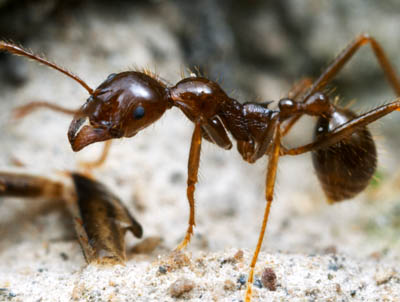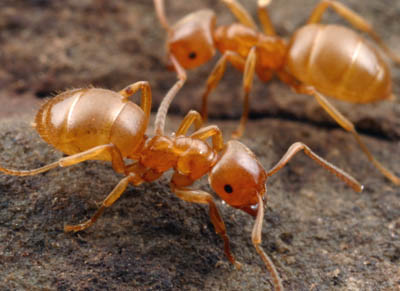Finally, a solid taxonomy for the Australian Aphaenogaster:

Shattuck, S. 2008. Australian ants of the genus Aphaenogaster (Hymenoptera: Formicidae). Zootaxa 1677: 25-25.
ABSTRACT: The Australian species of the myrmicine ant genus Aphaenogaster Mayr are revised. Eight species are recognised, four of which are described as new. The species include barbara sp. n., barbigula Wheeler (for which a lectotype is designated), kimberleyensis sp. n., longiceps (Smith) (with its newly recognised synonym, flava Emery), mediterrae sp. n., poultoni Crawley, pythia Forel (for which a neotype is designated) and reichelae sp. n. Aphaenogaster is widely distributed across eastern and southern Australia (except Tasmania), with isolated populations in northern Northern Territory and northern Western Australia. Species occur in a range of habitats from rainforests through open woodlands and can be of significant economic importance because of damage caused by their nests.
Pin-headed ant larvae explained:

Masuko, K. 2008. Larval stenocephaly related to specialized feeding in the ant genera Amblyopone, Leptanilla and Myrmecina (Hymenoptera: Formicidae). Arthropod Structure and Development. 37: 109-117.
ABSTRACT: Larvae of the ant genera Amblyopone, Leptanilla and Myrmecina have unusually minute crania. This characteristic is here termed stenocephaly. To study it in detail larvae of the three genera were examined morphometrically and histologically in comparison with other non-stenocephalous larvae of the genera Cryptopone and Manica. The stenocephalous larvae are very specialized, in that their supra- and sub-esophageal ganglia are entirely displaced into the anterior thoracic segments, apparently as a consequence of the small cranial capacity. In Amblyopone and Leptanilla the small cranium appears to facilitate group feeding by a large number of larvae on the whole, intact bodies of the specialized centipede prey characteristic of these genera. In Myrmecina, the small, elongate head adapts the larva to consume the contents of the partly opened bodies of oribatid mites, which are the specialized prey of this genus. Therefore, stenocephaly seems to be a larval morphological adaptation facilitating specialized predation in these ants. These morphological specializations by ant larvae, and active larval involvement in prey dissection are possible because ants rear the larvae without confining them in cells. Acellular nests, a universal feature in Formicidae, may thus facilitate larval adaptations of benefit both to the larvae themselves and to the functionality of parental colonies, allowing them more efficiently to exploit accessible prey through well-integrated cooperation between adult and immature individuals.
Attines aren't the only ants with a fungal mutualism:

Schlick-Steiner et al. 2008. Specificity and transmission mosaic of ant nest-wall fungi. PNAS 105: 940-943.
ABSTRACT: Mutualism, whereby species interact to their mutual benefit,is extraordinary in a competitive world. To recognize generalpatterns of origin and maintenance from the plethora of mutualisticassociations proves a persisting challenge. The simplest situationis believed to be that of a single mutualist specific to a singlehost, vertically transmitted from one host generation to thenext. We characterized ascomycete fungal associates culturedfor nest architecture by the ant subgenera Dendrolasius andChthonolasius. The ants probably manage their fungal mutualistsby protecting them against fungal competitors. The ant subgeneradisplay different ant-to-fungus specificity patterns, one-to-twoand many-to-one, and we infer vertical transmission, in thelatter case overlaid by horizontal transmission. Possible evolutionarytrajectories include a reversal from fungiculture by other Lasiussubgenera and inheritance of fungi through life cycle interactionsof the ant subgenera. The mosaic indicates how specificity patternscan be shaped by an interplay between host life-cycles and transmissionadaptations.
- Log in to post comments
